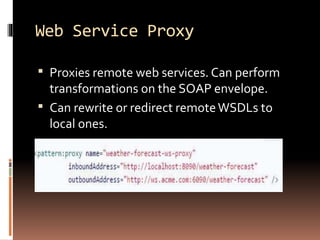Using mule configuration patterns
- 1. USING MULE CONFIGURATION PATTERNS : Presented By SindhuVL
- 2. Introduction : Configuring Mule involves XML, and though using a decent XML editor can help a lot, there are still a enough angle brackets to warrant a coffee break as projects get more complicated. As the number of flows and components in a Mule project increases, so does the amount of noise in its configuration files, making it harder and harder to understand and maintain them.
- 3. XML namespace: xmlns:pattern=http://www.mulesoft.org/sc hema/mule/pattern XML Schema location: http://www.mulesoft.org/schema/mule/pat tern http://www.mulesoft.org/schema/mule/pat tern/3.1/mule-pattern.xsd
- 4. Pattern Types : Simple Service Web Service Proxy Bridge Validator HTTP Proxy
- 5. Simple Service : Exposes JAX-WS annotated components as SOAP web services. Exposes JAX-RS annotated beans as RESTful components. The simple service pattern is used to expose a component as a request-response service. Several types of components are supported: POJOs JAX-WS services JAX-RS services JAXB and XPath processing components
- 6. Web Service Proxy Proxies remote web services. Can perform transformations on the SOAP envelope. Can rewrite or redirect remoteWSDLs to local ones.
- 7. Bridge : Establishes a direct conduit between an inbound endpoint and an outbound endpoint. Supports request-response and one-way bridging. Can perform transformations. Supports transactional bridging of inbound to outbound. The bridge pattern is used to bridge an inbound and outbound endpoint. Here’s an example that bridges an http and vm endpoint:
- 8. Validator : Validates inbound messages against a defined acceptance filter. Returns an ACK or NACK response synchronously and dispatches valid messages asynchronously.
- 9. HTTP Proxy : Sits between a caller application and a target web resource, propagating HTTP requests and responses. You can use it to access remote web resources in a controlled manner.
- 10. Configuration patterns, which are, by design, not as powerful as either of the others.They have instead been designed for ease of use.The four configuration patterns that exist today make things that people do all the time simple, understandable, and fast to create. In short, if one of the configuration patterns solves your problem, use it. It’s like using a library class that solves a programming problem instead of coding a new one that duplicates it. If your problem doesn’t match one of the configuration patterns, use a flow.










